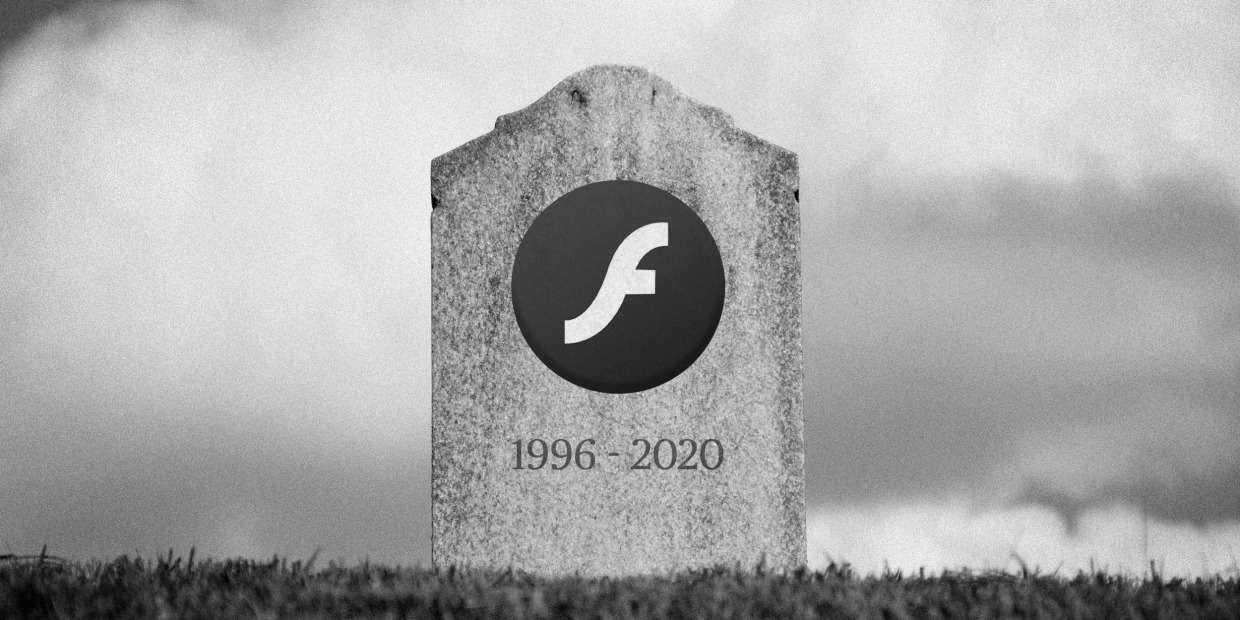- 20 December 2023
- No Comment
- 175
1996 – 2020: Was Adobe Flash Killed by Steve Jobs?

But let’s rewind a bit and dive into what exactly Adobe Flash was.
In the 2000s, Flash was the go-to animation tool. It was the maestro behind the scenes, allowing us to indulge in streaming videos, audio, and a whole world of multimedia wonders.
The real charm, however, lay in its ability to bring animations and games to life, supporting various formats like GIF, PNG, and the iconic FLV.
Why did Flash become our digital hero?
Well, rewind a bit more to the dial-up days. Internet speeds were snail-paced, and downloading anything was a test of patience. Enter Flash, with its vector-based graphics that meant tiny animations that could zip through the web at a speed that was music to our ears.
What’s more, it played nice with almost every browser out there. A simple plugin was the secret handshake to unlock a universe of online entertainment.
And so, the love affair with Adobe Flash began, turning those slow internet woes into moments of digital delight.
But as the saying goes, all good things must come to an end. Let’s unravel the story behind the shutdown of our beloved Adobe Flash.
The Begining
Back in 1996, Jonathan Gay and Charlie Jackson unleashed FutureSplash Animator upon the world, a tool designed to make animation creation a breeze. Little did they know that their experiment would skyrocket in popularity, making FutureSplash a household name in animation tools.
The plot thickens as FutureSplash caught the eye of Macromedia, leading to its acquisition. Out came Macromedia Flash 1.0, strutting onto the scene along with its trusty sidekick, the Macromedia Flash Player browser plugin.
Fast forward to 2005, and Adobe stepped into the picture, acquiring Macromedia and giving birth to the iconic “Adobe Flash Player.” It’s like our favorite superhero got a new cape.
Peak Era: The Zenith of Adobe Flash
Flash was the internet superstar of the 90s. If you were serious about making cool websites back then, you had to know your way around Flash—it was like having a magic wand for the digital world.
But here’s the fun part: Flash wasn’t just for the tech pros. It was a hit with creative folks who wanted to jazz up the internet with interactive content. Picture this: a tool that lets you mix videos, animations, and interactive stuff, turning your website into a virtual playground.
What made Flash so cool?
Well, it was like having super-easy drawing tools that let anyone be an online Picasso. And to make it all work, there was this thing called the web player plugin—it’s like the backstage pass to the coolest online party.
Flash wasn’t just a tool; it was a game-changer for making websites way more exciting.
Flash didn’t just make websites look cool—it made gaming awesome too! In 1998, a guy named Tom Fulp created a place called NewGrounds where people could play Flash games. It became this huge online hangout, all thanks to Flash.
18 million people were showing up every month to play Flash games on NewGrounds. If you were lucky enough to get your game on the front page, you were basically a gaming superstar.
But Flash didn’t stop at gaming; it shook up the whole internet in the late 1990s and early 2000s. Suddenly, animations were everywhere—games, websites, even online videos. It was like a digital explosion that gave birth to new jobs and animation companies.
By August 2006, Adobe Flash Player was the reigning champ, dominating the software platform realm. It played nice with over 2 million professionals and graced more than 97% of desktops connected to the internet.
In 2007, Flash CS3 made its debut under the Adobe banner, flexing its muscles with improved integration with Adobe Photoshop, upgraded QuickTime video export, and a host of other enhancements. It was like Adobe Illustrator and Adobe Fireworks had a tech-savvy sibling.
Zooming ahead to 2011, nearly 3 out of 10 websites were flaunting some Flash content, showcasing its widespread influence.
Major Issues of Adobe Flash
Flash had its heyday, but trouble was brewing on the horizon. Let’s break down the major headaches folks faced:
Hard to Update:
Installing new Flash versions meant waving goodbye to the old ones, causing a headache for users. Mixing HTML with Flash applications? Let’s just say it was like trying to fit a square peg into a round hole.
Privacy Stress:
Flash had this habit of storing data locally, including sensitive stuff like login details and preferences. Privacy alarms were ringing loud and clear.
Security Nightmares:
Flash had more holes than a slice of Swiss cheese. In 2010, there was a critical security glitch that Adobe took a whole year to patch up. People weren’t thrilled about playing Russian roulette with their online safety, so some just said, “No thanks, Flash.”
Slow and Clumsy:
Flash got a bad rap for being slow and hogging up resources. It was like trying to run a marathon in quicksand.
Mobile Snub:
Flash missed the mobile memo. Most smartphones and tablets gave it the cold shoulder, making Flash a no-show on the mobile scene.
Steve Jobs and Adobe Flash
Apple and Adobe had a significant partnership, with Apple being one of Adobe’s early major customers and even holding a 20% stake in Adobe for a considerable period.
But Jobs wasn’t a fan of Flash, and he made it loud and clear in a letter called “Thoughts on Flash” in 2010.
Jobs had some serious issues with Flash. It was like a VIP club, all closed off and owned by Adobe. Flash also needed its plugin, making things a bit complicated for users.
But the real deal-breaker?
Flash wasn’t cool with touchscreens. It was stuck in the past, designed for mouse clicks, not swipes and taps. That meant extra work for web developers.
And then, Jobs dropped the bomb—Flash was a performance nightmare and a security risk. It was crashing Apple devices left and right.
To top it off, Adobe wasn’t playing nice with Apple’s iOS features. Jobs wanted software that worked seamlessly with iOS, and Flash just wasn’t cutting it.
Jobs might have thrown a few punches that contributed to Flash’s eventual exit from the stage Jobs’s strong stance against Flash led to Apple’s decision to exclude Flash support from iOS devices.
In hindsight, it does seem like a missed opportunity for Adobe. The reluctance or challenges in adapting Flash to the evolving preferences of iOS users proved to be a significant factor in the decline of Flash’s relevance.
Impact on Users and Developers:
User Migration: Flash’s decline prompted users to migrate towards platforms and content that embraced newer technologies. Browser support for Flash dwindled, and users were encouraged to adopt alternatives that offered a more seamless and secure experience.
Developer Transition: Web developers faced the challenge of transitioning from Flash to alternative technologies. Many embraced HTML5 and other open standards to ensure compatibility and meet evolving industry standards.
Did Adobe Officially Close the Chapter?
Flash had a rough ride post-2010. People were not happy with its performance, security glitches, and privacy concerns. The rise of competitors, especially open-source platforms like HTML5 and CSS3, didn’t help Flash’s case either.
Here’s the scoop: Google spilled the beans that the number of folks visiting Flash websites dropped from a whopping 80% to a mere 17%. Ouch.
And then came the big announcement in 2017: Adobe, the parent company of Flash, declared that they were pulling the plug. Flash officially said its goodbyes and closed shop on December 31, 2020.
Legacy and Continuation
Flash Player may have taken its final bow, but Flash, the authoring tool, is still hanging around like the cool kid in the corner.
Sure, its glory days might be behind, but Flash hasn’t packed up and left the building. Animators still find it handy, and in some niche business corners, it’s still strutting its stuff.
And guess what?
Flash is having a little after-party on NewGrounds. Thanks to open-source magic and the support of HTML5, select Flash content is still alive and kicking on the platform.
Nabeel Shaikh’s Insights
The closure of Adobe Flash stands not just as an event but as a significant case study in the dynamic evolution of digital technologies. It’s a narrative that underlines crucial lessons about adaptability, user-centricity, and the imperative of aligning with industry trends for lasting success in the digital landscape.
Adaptability as a Cornerstone:
Flash, once a digital powerhouse, faltered due to a lack of adaptability. In the face of emerging technologies and shifting user preferences, Flash struggled to evolve. The inability to swiftly adjust its course and embrace newer standards ultimately played a pivotal role in its decline.
Responsiveness to User Needs:
User needs are the heartbeat of any successful technology. Flash faced a multitude of issues—from performance glitches to security concerns—and user dissatisfaction grew. The lesson here is clear: staying attuned to user needs, actively addressing concerns, and prioritizing user experience are non-negotiable aspects of sustained relevance.
Strategic Alignment with Industry Trends:
The clash between Flash and emerging technologies like HTML5 and CSS3 illustrates the critical importance of strategic alignment with industry trends. Flash’s closed ecosystem and lack of support for mobile devices became glaring shortcomings in an era where open standards and mobile-friendliness were gaining precedence.
The Ever-Changing Digital Ecosystem:
The digital ecosystem is a dynamic realm where change is constant. Flash’s story is a reminder that businesses and technologies must be agile and ready to pivot as the digital landscape evolves. Staying ahead of the curve requires a proactive approach to anticipate and adapt to the ever-changing needs and preferences of users and industry standards.
Legacy and Lessons Learned:
While Flash Player bid adieu, the Flash authoring tool and traces of its content linger on. Its legacy offers a reflection on the tech industry’s ability to learn and adapt. The open-source emulation on platforms like NewGrounds showcases that even in retirement, elements of Flash persist, serving as a testament to its historical impact.
In essence, the shutdown of Adobe Flash is more than a mere event; it’s a rich source of insights for businesses navigating the digital landscape.
The key takeaways are clear: be adaptable, responsive to user needs, align strategically with industry trends, and be ever-ready to evolve in the dynamic dance of the digital ecosystem.
Flash’s story is a chapter in the larger narrative of technological evolution, a story of rise, fall, and the enduring lessons that shape the future.

